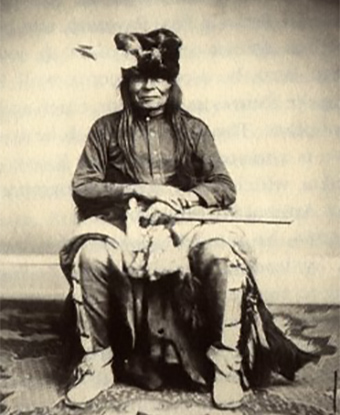Last updated: September 7, 2020
Person
Struck By The Ree

NPS, Missouri NRR; Trustees of the British Museum
Struck By The Ree was a realist whose life begins in legend. The story goes that in 1804, Lewis and Clark were on their famous expedition and heard about the birth of a baby boy nearby. They asked to see him and proceeded to wrap the baby in an American flag. Some versions of the story claim that the explorers baptized him as an American while others claim the men predicted the child would grow into a great leader.
The explorers themselves did not note this event, but they did hold a council with the Ihanktonwan Tribe at Calumet Bluff the year Struck By The Ree was presumably born. The story serves as a symbolic reminder of the relationship that Struck By The Ree attempted to cultivate between his people and the growing Euro-American population.
There is much that is not known about Struck By The Ree. His name was supposedly earned in combat against the Arikara (also known as the Ree). He is often referred to as either Struck By The Ree or Strike The Ree, but signed the Treaty of 1858 as Pa-la-ne-a-pa-pe, the man that was struck by the Ree. As a grown man, he became the principal chief of the Ihanktonwan (Yankton) Tribe.
After George Catlin's 1836 visit to the pipestone quarries provoked widespread curiousity and interest, Euro-American settlers began arriving in increasingly large numbers. Struck By The Ree visited Washington D.C. in 1857 to lobby on behalf of his people, but to no avail. He is credited with saying:
"The white men are coming like maggots. It is useless to resist them. They are many more than we are. We could not hope to stop them. Many of our brave warriors would be killed, our women and children left in sorrow, and still we would not stop them. We must accept it, get the best terms we can get and try to adopt their ways."
Struck By The Ree sought to create a peaceful coexistence between the new settlers and his people in the face of massive cultural upheaval. In 1858, the U.S. government drafted a treaty that ceded to it over 11 million acres and placed the Ihanktonwan on a 475,000-acre reservation 150 miles from the pipestone quarries with the promise of education, agricultural training, and $1.6 million over 50 years. Struck By The Ree refused to sign it unless his people were guaranteed free and unrestricted use of the pipestone quarries. The government agreed and created a unique, 1-square mile reservation intended specifically to protect the quarries.
Despite broken promises and mistreatment of his people (which he would later speak against in the Doolittle Commission), Struck By The Ree continued to push for peaceful relations between Indigenouns people and Euro-Americans. In the U.S.-Dakota War of 1862, he even warned white settlers of the impending violence, althought this did not spare him from the settlers' vengeance in the war's aftermath as the Dakota people were expelled from Minnesota and bounties were places on their scalps.
Although little is written about Struck By The Ree, what has been recorded about him reveals a gift for the long view. He never stopped trying to help the Ihanktonwan Oyate adapt to change and was firm in his argument for peace. Presidents Pierce, Grant, and Garfield all gave Struck By The Ree medals to commemorate his tireless efforts to establish peaceful relations between American Indians and Euro-Americans. Furthermore, without his insistance and foresight in 1858, would the pipestone quarries have survived either the onslaught of settlement and rapid development or possible overuse by non-Natives?
